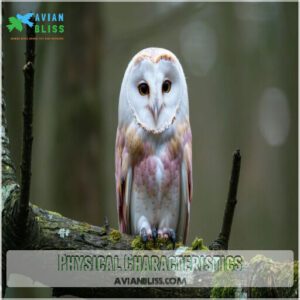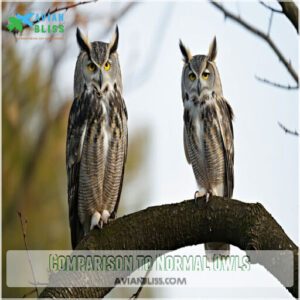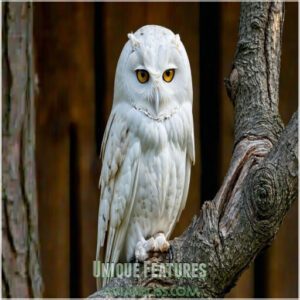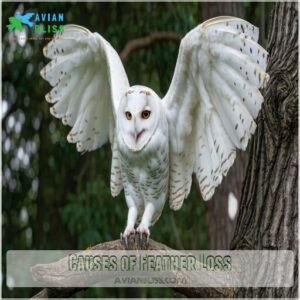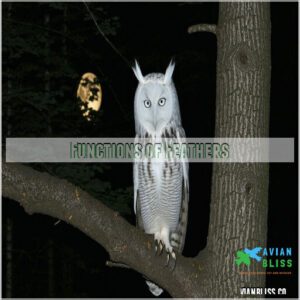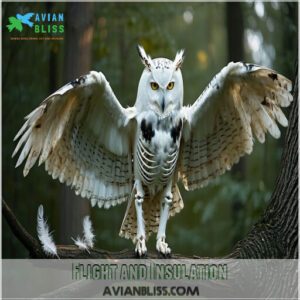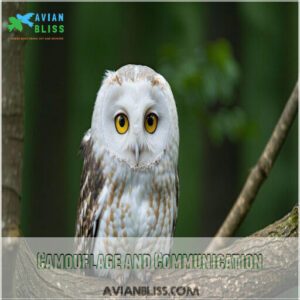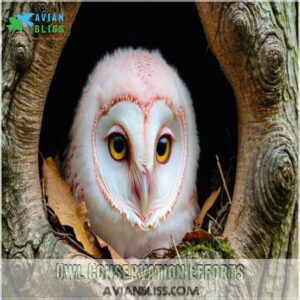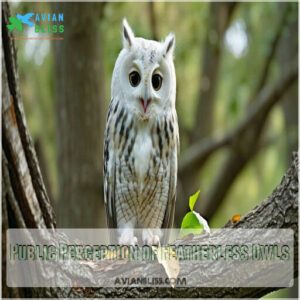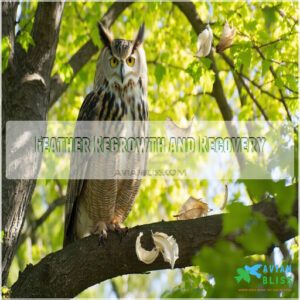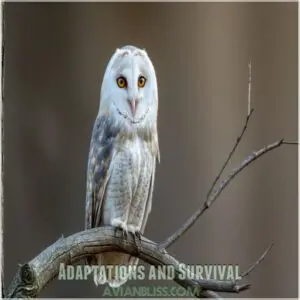This site is supported by our readers. We may earn a commission, at no cost to you, if you purchase through links.
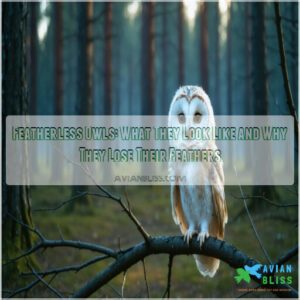 You’re wondering about featherless owls, and what you’ll find is quite surprising.
You’re wondering about featherless owls, and what you’ll find is quite surprising.
Without feathers, owls appear smaller and more fragile, with prominent eyes and sharp talons.
Feather loss can be due to molting, injury, disease, or environmental factors.
As you explore the domain of featherless owls, you’ll discover the vital role feathers play in their survival, and how conservation efforts are in place to help these birds regain their remarkable plumage, setting them up for a flight back to full health and stealthy hunting prowess.
Table Of Contents
- Key Takeaways
- Featherless Owl Appearance
- Causes of Feather Loss
- Importance of Feathers
- Owl Conservation Efforts
- Public Perception of Featherless Owls
- Feather Regrowth and Recovery
- Adaptations and Survival
- Frequently Asked Questions (FAQs)
- What is a featherless owl?
- Are owls without feathers real?
- What does a featherless owl look like?
- Are featherless owls dangerous?
- What is an owl without feathers called?
- Why do owls turn featherless?
- Can an owl survive without feathers?
- Why is it illegal to own an owl feather?
- What is the difference between a lechuza and an owl?
- Why put a fake owl in your yard?
- Conclusion
Key Takeaways
- You’ll find that featherless owls are vulnerable and need protection, as they’ve lost their feathers due to molting, injury, or disease, which affects their appearance and survival.
- Without feathers, owls can’t fly silently, lose insulation, and are more visible to predators, making conservation efforts crucial for their well-being and survival.
- You’ll discover that feather regrowth in owls depends on several factors, including nutrient intake, environmental conditions, and hormonal balance, and that veterinary care can help address feather loss and molting issues.
- By supporting conservation efforts and learning about featherless owls, you’ll appreciate the importance of protecting these birds and their habitats, and understand how you can contribute to their recovery and thrive.
Featherless Owl Appearance
When an owl loses its feathers, its bare skin and slender frame become fully exposed, revealing a strikingly different appearance.
Without their dense plumage, they look smaller and more fragile, with prominent eyes and sharp talons standing out.
Physical Characteristics
Featherless owls reveal a fascinating glimpse into owl anatomy.
Without their feathers, their body shape appears slim and delicate, with exposed skin texture varying from pale pink to gray.
Facial features like their large eyes and sharp beak formation become more pronounced, while their talon structure looks strikingly formidable.
Feather loss, whether from molting or other causes, leaves these owls appearing vulnerable yet still retaining their unique owl characteristics.
The unique physical traits of owls, including their silent flight features, are essential to their survival and hunting success.
Comparison to Normal Owls
You’ve already learned about the physical appearance of featherless owls, but how do they stack up against their feathered counterparts.
Without their plumage, they lose the sleek silhouette and graceful flight patterns that define typical owl characteristics.
Feather loss impacts more than looks—it affects insulation and behavior too.
- Featherless owls appear smaller and less imposing.
- Their exposed skin contrasts with feathered textures.
- Flight becomes noisier and less efficient.
- Behavioral changes may emerge due to vulnerability.
Unique Features
An owl without feathers looks strikingly different yet retains its recognizable facial structure and body shape.
The exposed skin texture, often smooth and vascularized, highlights their skeletal frame.
Eye features become even more pronounced, dominating their bald appearance, while the beak formation remains sharp and defined.
Unlike other featherless bird species, bald owls seem smaller and more delicate, their bare bodies offering a rare glimpse into their hidden anatomy, and presenting a unique view of their overall body shape.
Causes of Feather Loss
Feather loss in owls can happen for several reasons, ranging from natural molting to health issues like disease or injury.
Environmental stress, parasites, and poor nutrition also play a significant role in disrupting their feather growth and maintenance.
Molting and Natural Processes
When owls lose feathers, it’s often part of the natural molting cycle.
This process replaces old, worn feathers with fresh ones, ensuring proper feather development and functionality.
Molting follows specific growth patterns, allowing owls to maintain flight and insulation.
Natural shedding is gradual, so they’re never left completely bare, and with proper avian care, feather regrowth happens efficiently.
Injury and Disease
Injury and disease can wreak havoc on an owl’s feathers, leaving them vulnerable.
Trauma effects, like collisions, often damage feathers or cause loss. Diseases such as avian pox or aspergillosis disrupt feather regrowth and overall health.
Nutritional deficiencies can cause feather loss and impact overall health, according to this helpful resource about owls.
Here’s how:
- Feather infections weaken structure, causing loss.
- Injury response delays molting cycles.
- Disease transmission impacts long-term avian care.
Environmental Factors
Extreme weather and pollution effects aren’t just human problems—they hit wildlife too.
Climate change alters habitats, forcing owls into harsher conditions. Habitat loss leaves them vulnerable, while toxins in the environment weaken feather growth.
These environmental factors lead to feather loss, making featherless owls more exposed. Owl conservation efforts must address these ecological impacts to protect their survival.
Nutritional Deficiencies
Without proper food quality and balanced dietary needs, featherless owls can face serious malnutrition effects.
Nutritional deficiencies, like a lack of essential vitamins, weaken feather growth and overall bird health.
Vitamin deficiency or nutrient deficits often result in brittle feathers or complete feather loss.
Prioritizing owl nutrition ensures they maintain strong plumage and avoid the challenges of nutritional-related feather loss.
Providing adequate owl vitamin supplements is essential for their overall health and well-being.
Importance of Feathers
Feathers are essential for an owl’s survival, serving critical roles in flight, insulation, camouflage, and communication.
Without them, an owl’s ability to hunt, stay warm, and evade predators is greatly compromised.
Functions of Feathers
Feathers aren’t just for Looks—they’re multitaskers.
Their structure supports silent flight and precise movement.
Here’s why they matter:
- Flight Mechanics: Feathers create lift and control.
- Insulation Properties: They trap warmth, protecting against cold.
- Camouflage Techniques: Patterns help owls blend into surroundings.
- Aerodynamic Benefits: Streamlined shapes improve hunting efficiency.
Feather maintenance is critical; without it, regrowth struggles, and feather loss impacts survival.
The unique silent flight features of owl feathers play an essential role in their hunting success.
Flight and Insulation
Feathers are engineering marvels, combining aerodynamic features with thermal regulation.
They create efficient flight mechanics, allowing owls to glide silently.
Without them, featherless owls lose insulation, struggling to maintain body heat.
Molting guarantees damaged feathers are replaced, aiding survival.
| Feature | With Feathers | Without Feathers |
|---|---|---|
| Flight Patterns | Smooth, silent gliding | Clumsy, noisy descent |
| Insulation | Retains body heat | Exposed to cold |
| Feather Structure | Strong, lightweight | Absent, vulnerable |
Feather regrowth restores these essential functions, ensuring that owls can maintain their thermal regulation and engage in efficient flight.
This process is crucial for their survival, as it replaces damaged feathers and aids in maintaining body heat.
Camouflage and Communication
Feathers aren’t just for flight—they’re nature’s ultimate disguise and messaging system.
Owls use plumage patterns as camo strategies, blending seamlessly into trees or shadows. Feather signals also play a role in owl behavior, helping them communicate with mates or rivals.
For featherless owls, this advantage disappears, leaving them vulnerable. Silent flight, too, relies on specialized plumage. Without it, their stealth is compromised.
- Camo Strategies: Blend into surroundings.
- Feather Signals: Communicate visually.
- Plumage Patterns: Aid in concealment.
- Silent Flight: Enables undetected hunting.
Owl Conservation Efforts
You play an important role in protecting owls by supporting conservation efforts that address feather loss and habitat threats.
From specialized veterinary care to creating safe environments, these actions make sure their survival and well-being, which is crucial for their well-being.
Conservation Centers
Feathers are critical, but when they’re gone, conservation centers step in.
These sanctuaries, like Hawk Creek Wildlife Center, focus on bird rehabilitation and wildlife rescue.
Through specialized avian care, they address featherless owl conservation by managing habitats and promoting recovery.
Here’s a quick look:
| Focus Area | Example Center | Location | Key Role |
|---|---|---|---|
| Rehabilitation Methods | Hawk Creek Wildlife Center | New York State | Owl recovery support |
| Wildlife Rescue | DuPage Wildlife Conservation | Illinois | Treating injured owls |
| Sanctuary Management | Northern Spotted Owl Strategy | Federal lands | Habitat preservation |
| Conservation Efforts | Artificial Nest Installations | United Kingdom | Boosting owl populations |
Veterinary Care
Veterinary care plays a critical role in owl rehabilitation, especially for featherless owls.
Avian medicine guarantees proper diagnosis and treatment, helping restore animal health. Helpful owl rehabilitation products support recovery.
Wildlife veterinary care often includes:
- Veterinary treatment for injuries or infections.
- Bird surgery to address severe trauma.
- Feather repair techniques for damaged plumage.
- Ongoing support from veterinarians for recovery.
Veterinary medicine safeguards owls’ survival and well-being.
Nutritional Support
A balanced diet is critical for featherless owls to recover.
Protein intake supports feather regrowth, while vitamin supplements and mineral balance improve overall health.
Meeting caloric needs through dietary planning prevents further nutritional issues.
Supplementing with the right owl vitamin supplement can be beneficial.
| Nutrient | Purpose | Sources |
|---|---|---|
| Protein | Feather regrowth | Insects, small prey |
| Vitamins | Immune support | Fruits, vegetables |
| Minerals | Bone/feather strength | Seeds, supplements |
Habitat Protection
Protecting owl habitats means safeguarding the ecosystems they rely on.
Habitat conservation supports biodiversity protection and maintains environmental safety for these birds.
Wildlife preservation efforts focus on reducing deforestation, pollution, and urban sprawl that threaten owl habitats.
By prioritizing ecosystem management, you’re helping maintain balance in nature, giving owls a chance to thrive through effective wildlife conservation and ecosystem conservation strategies.
Conservation initiatives often involve bird conservation efforts to protect species and their habitats.
Public Perception of Featherless Owls
When you first see a featherless owl, it’s hard not to be surprised by its strikingly bare appearance.
Public reactions often highlight a mix of fascination and discomfort, revealing how much feathers shape our perception of these birds.
Social Media Reactions
You witness public shock on social media as naked owls go viral, with a viral tweet sparking digital engagement and online trends.
While some compare their alienlike appearance to dinosaurs, prompting social backlash and discussion about these unusual creatures on Twitter.
Many owl species face serious conservation threats, which is a critical issue that requires attention, and it’s also worth noting the viral tweet and alienlike appearance that sparked the conversation.
Cultural Commentary
You see the cultural significance of featherless owls, with their alien-like appearance sparking public opinion and social impact discussions.
Media ethics come into play when sharing images of naked owls, highlighting the need for sensitivity and respect for these symbolic creatures, raising owl awareness about their unique plight, and considering the importance of respect.
Ethical Concerns
The public’s fascination with featherless owls raises ethical concerns, especially regarding animal welfare and photo ethics.
Here are some considerations:
- Animal Welfare: Featherless owls are vulnerable; their exposure in media should be handled sensitively, prioritizing their well-being.
- Photo Ethics: Photographers should respect owls’ dignity, avoiding exploitative images that emphasize their unusual appearance.
- Conservation Responsibility: Images of featherless owls must be used responsibly, highlighting their conservation status and the importance of habitat protection.
- Wildlife Protection: The focus should be on protecting these birds, not exploiting them for viral content.
- Ethical Treatment: Conservationists and the public must work together to guarantee ethical treatment and care for these unique birds.
Feather Regrowth and Recovery
You’ll learn how owls regrow their feathers through the molting process, and what factors can affect this process.
By understanding feather regrowth and recovery, you can better appreciate the importance of conservation efforts and veterinary care for featherless owls.
Molting Process
You’re exploring the molting process, where owls shed old feathers, making way for new ones.
This natural plumage cycle, or molting process, involves feather shedding, leading to feather regrowth, and is essential for owl feathers and overall health, including fledgling development and feather regeneration.
Factors Affecting Regrowth
Molting is just the first step.
Feather regrowth in featherless owls depends on several factors, including nutrient deficiency, which can hinder feather regeneration, while environmental stress can disrupt molting.
Hormonal balance and genetic factors also play a role in the success of feather regrowth.
Think of it like baking a cake:
- Flour (nutrients)
- Oven temperature (environment)
- Recipe (genetics), where all these elements, including hormonal balance and genetic factors, come together to determine the outcome.
Veterinary Assistance
You’ll need veterinary care for your featherless owl, specializing in Avian Medicine and Bird Surgery.
Experts in Owl Rehabilitation can provide Feather Repair guidance, addressing feather loss and molting issues, to guarantee your owl’s avian health and well-being.
Especially when dealing with featherless owl disease, helping them regain their feathers, is crucial for their overall well-being.
Adaptations and Survival
You’ll explore how featherless owls adapt to their environment and survive without their typical insulation and protection.
By understanding these adaptations, you’ll gain insight into the unique challenges and advantages that come with being a featherless owl.
Unique Feather Structures
You examine unique feather structures, noting owl feathers have distinct barbs, feather texture, and wing shape.
Various plumage types and feather patterns exist, with molting affecting feather loss in featherless owls, impacting their plumage and overall appearance.
The importance of understanding owl feathers and their structure highlights the need to study these aspects thoroughly, to comprehend how they contribute to the overall appearance and functionality of owls.
Adaptations for Silent Flight
As you explore silent flight, consider these adaptations:
- Wing Structure
- Feather Texture
- Aerodynamic Shape
- Noise Reduction
- Specialized Feathers, enabling nocturnal birds like owl feathers to master silent flight, essential for hunting and survival, even in featherless owls.
The key to mastering silent flight lies in the combination of these adaptations, particularly the specialized feathers that allow birds to fly quietly.
Variations in Feather Size and Color
You observe variations in feather size and color among owl species, known as Feather Pigmentation and Color Patterns.
You also notice Size Variance and Plumage Texture differences, all part of Feather Morphology.
Even in featherless owls that have experienced feather loss due to molting or other factors, these characteristics are still considered.
Evolutionary Advantages of Feathers
You explore feather evolution, discovering aerodynamic benefits, thermal regulation, and sensory functions. Adaptive traits in owl evolution highlight feather function, showcasing plumage science in bird anatomy, even in featherless owls.
Frequently Asked Questions (FAQs)
What is a featherless owl?
You’ll find a featherless owl is fundamentally a bird that’s lost its feathers due to various reasons, such as molting, injury, or disease, affecting its appearance and overall health substantially.
Are owls without feathers real?
You’ll discover that, yes, owls without feathers are real, often due to molting, injury, or disease, affecting their appearance and survival, making conservation efforts essential for their well-being.
What does a featherless owl look like?
You’ll see a bald, naked owl with exposed skin, lacking insulation and protection, its distinctive shape and features still visible, but altered noticeably without feathers.
Are featherless owls dangerous?
Actions speak louder than words" – you’ll find featherless owls aren’t typically dangerous, they’re usually vulnerable, needing protection from predators and elements, rather than posing a threat to humans.
What is an owl without feathers called?
You’ll call an owl without feathers simply a molting or featherless owl, as it’s a temporary condition due to natural shedding or health issues, not a distinct species.
Why do owls turn featherless?
You’ll find that owls turn featherless due to molting, injuries, diseases, or parasites, which can be a real hoot – or not, depending on the poor bird’s plight and health.
Can an owl survive without feathers?
You can’t survive without feathers, as they provide insulation, camouflage, and flight capabilities, making them essential for an owl’s survival and well-being in its natural environment naturally.
Why is it illegal to own an owl feather?
You can’t own an owl feather because it’s protected under laws like the Migratory Bird Treaty Act, which prohibits possessing certain bird parts, including feathers, without a permit.
What is the difference between a lechuza and an owl?
You’ll discover a lechuza is another term for an owl, particularly in Latin American cultures.
With no distinct difference between the two, just a variation in naming conventions and regional terminology, the term lechuza is used interchangeably.
Why put a fake owl in your yard?
You put a fake owl in your yard to deter pests, like rodents and birds, by creating a decoy predator, thereby protecting your garden and outdoor space naturally.
Conclusion
Imagine witnessing a featherless owl, its beauty lost.
You’ll discover that featherless owls face many challenges, and it’s essential you understand their plight.
By learning about featherless owls, you’ll appreciate the importance of conservation efforts to help them regain their feathers and thrive, ultimately saving these magnificent creatures, the featherless owls.
- https://medium.com/@josh.petdogplanet/the-fascinating-world-of-owls-without-feathers-89f3b5d0969a
- https://www.reddit.com/r/Ornithology/comments/12x3iqt/this_is_what_owls_look_like_without_feather/
- https://www.boredpanda.com/owls-without-feathers/
- https://www.pinterest.com/ideas/featherless-owl/937212464357/
- https://mpora.com/animals/owls-without-feathers/

